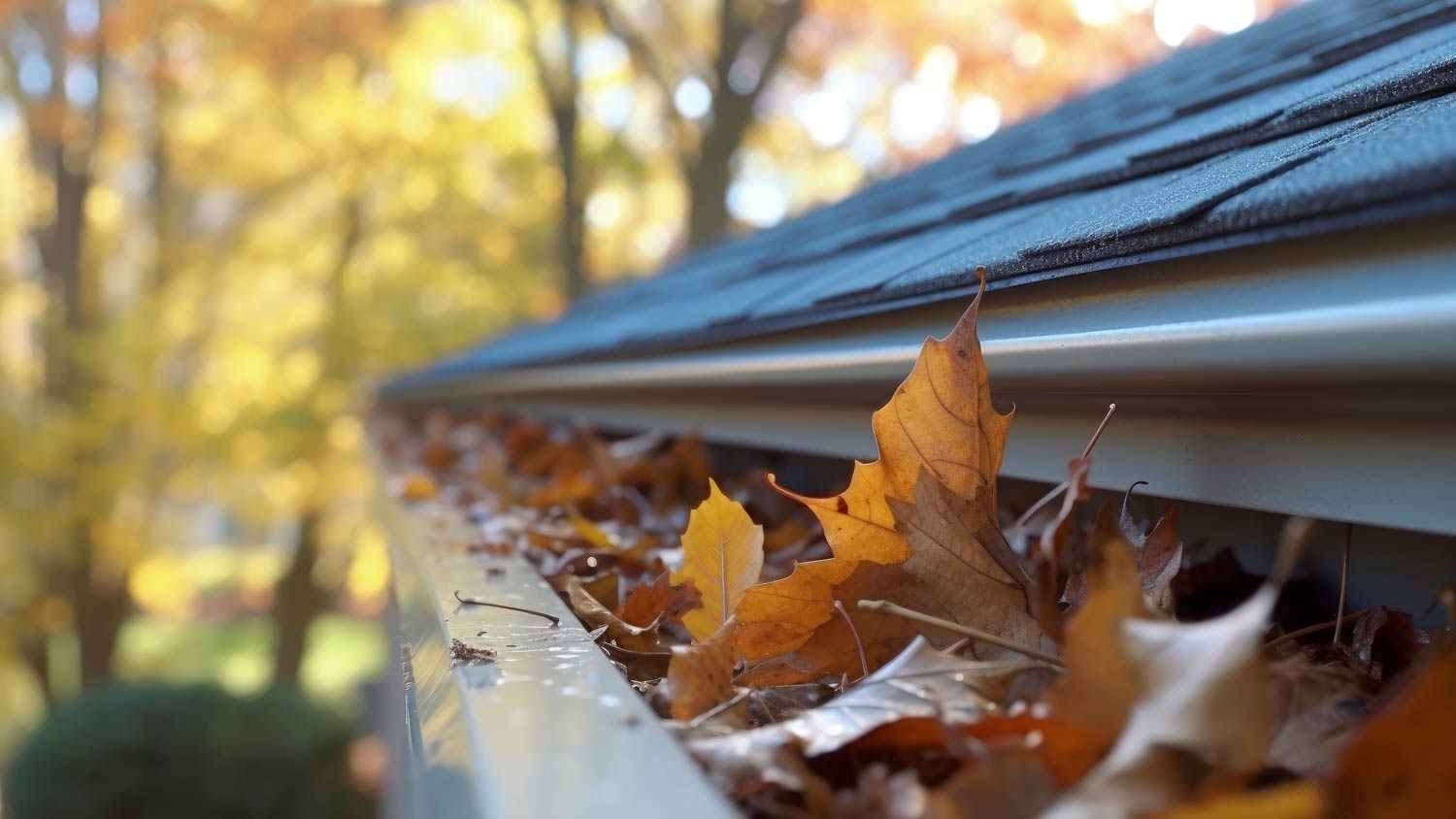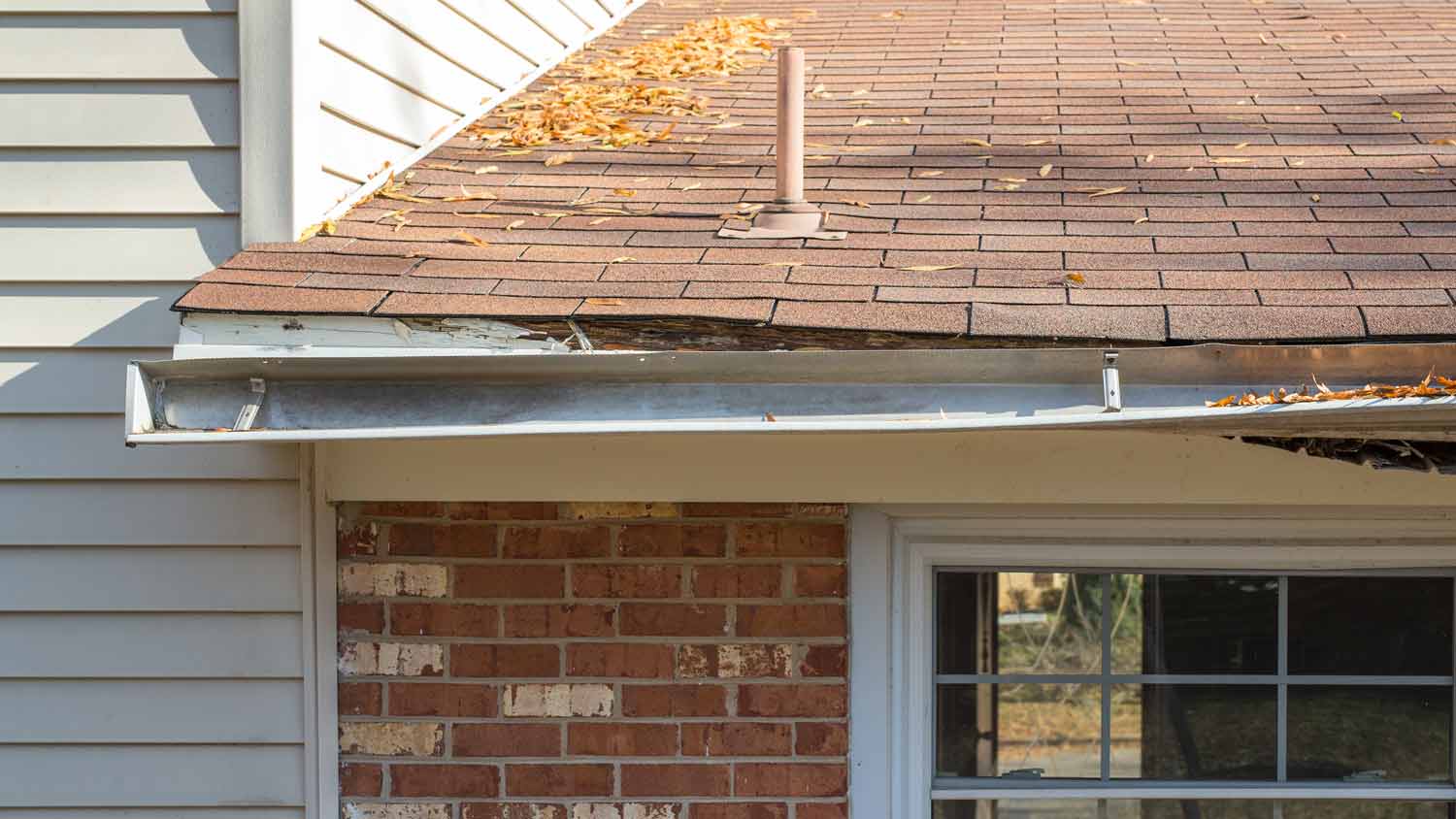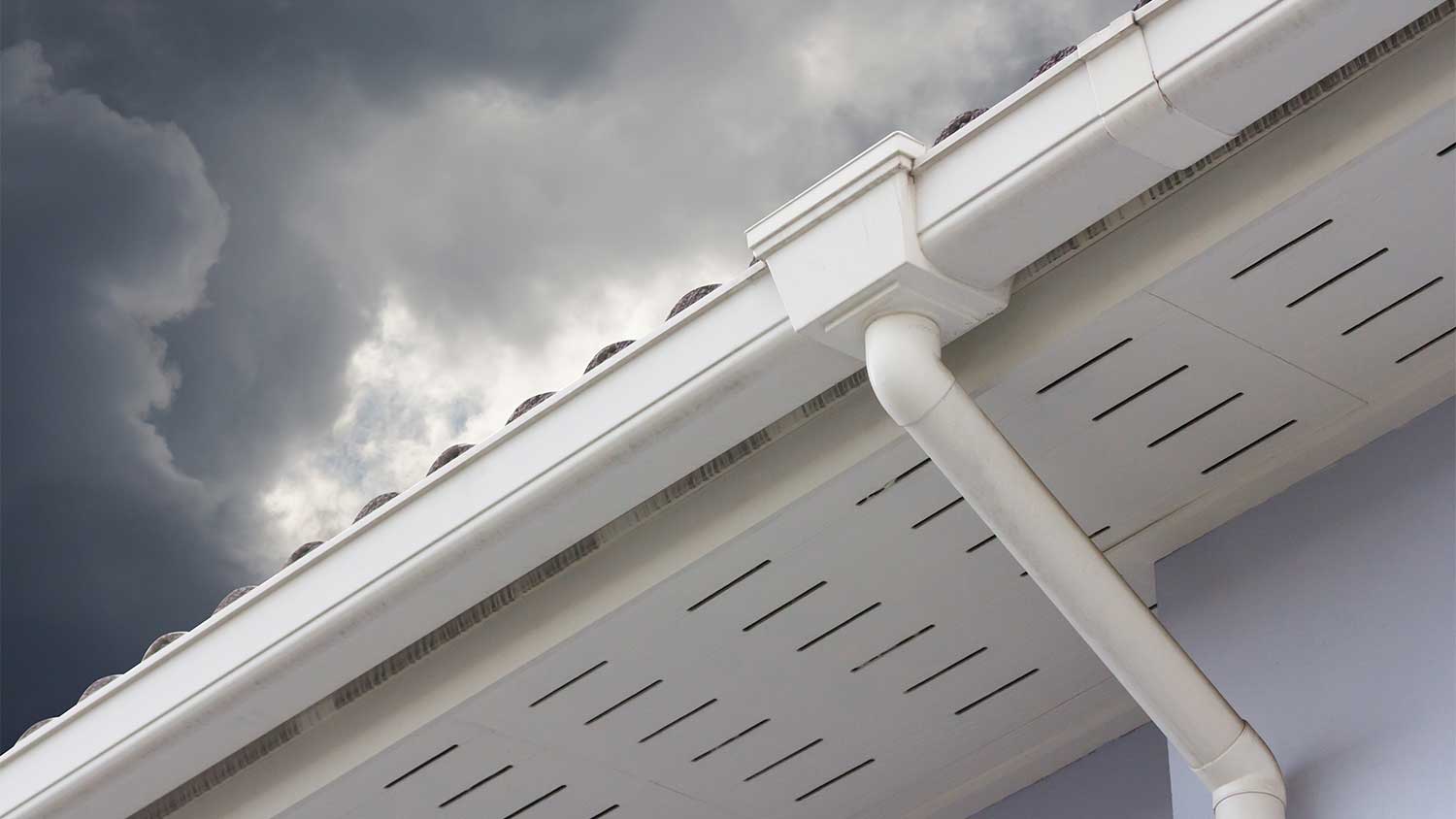Why Is Water Leaking Between the Gutter and Fascia?
Stop the leak before it’s too late


A faulty gutter system is a common cause for leaks.
New gutters cost between $4 and $30 per linear foot.
Regularly clean your gutters and downspouts for optimal performance.
Check your gutter slope for misalignments.
Work with a pro for extensive gutter repairs, replacements, or sizing issues.
Gutters are supposed to keep water away from your home—not send water cascading toward it. If you see or hear the telltale signs of water pitter-pattering between the gutter and fascia of your home, you’ll want to take action fast to protect the siding, roof, and perimeters of your house from water damage. We’ve rounded up some of the most common reasons for water leaking between gutters and fascias and what you can do to fix it.
1. Incorrect Gutter Installation
One of the most common causes for water leaking between gutters and fascias is incorrectly installed gutters. If you recently installed gutters on your home, then any number of installation mishaps can cause water to leak through the gutters and straight to your fascia. One wrong move, and you’ve got yourself a leaky problem on hand. Here are a few installation issues that can cause leaks:
Poor placement: Gutters that are installed too low or far away from the home won't be close enough to the roof to prevent water from leaking. The gutter hanger spacing plays a role in proper placement.
Missing flashing: If you DIYed your installation, there’s also a possibility that you forgot to install the flashing. This material is essential for preventing water from flowing behind the gutter.
Wrong slope: Installing gutters requires accurate measurements to encourage water to go in the right direction.
How to Fix It:
Fortunately, there are ways to troubleshoot the issue to solve the problem. But, since leaks can come from any place in a newly installed gutter system, it might be a good idea to have a professional gutter installation contractor check your gutters to see if there are any issues with the installation itself. That way, your pro can fix the gutters and have them up and running again come the next rain storm.
Additionally, if you had the gutters professionally installed, be sure to contact the company that installed them to have them take a look.
2. Clogged Gutters

Another common reason for having water leak between the gutter and fascia of your home is clogged gutters. As with any clog, leaf matter, branches, and other debris can find their way into your gutters and prevent water from flowing to the downspouts. If this happens, there's only one way for the water to go—up and over.
When the water goes over the edges of the gutter, it can flood toward the front of the gutters and hammer away at your garden beds, or it can make its way to the fascia and cause water damage to your home.
How to Fix It:
The solution? Gutter maintenance. Gutter cleaning is important because it helps prevent property damage, the perfect breeding ground for insects and mold. You should clean your gutters one to two times a year, depending on your climate and how many trees you have hovering above your gutters. Autumn is the best time to clean gutters to prevent clogs, as the leaves can quickly pile up and prevent water from streaming down.
You can either clean the gutters yourself or hire a gutter cleaning company to go in and do the job for you. Some homeowners prefer having a pro do the cleaning because professionals have all the tools and skills to safely climb on a ladder and clean gutters. Gutter cleaning costs anywhere between $75 and $400 or around $175 on average.
3. Clogged Downspouts
Just because your gutters aren't clogged doesn't mean that you’re in the clear. You should also check your gutter system’s downspouts for signs of blockages. The downspout serves as a funnel for draining water out of your gutters and down to the ground. Plugged downspouts can get backed up and cause overflowing gutters.
How to Fix It:
Clearing out clogged downspouts may require a different approach from clogged gutter cleaning. Common downspout cleaning tools include a gutter scoop, cleaning tongs, garden hoses, pressure washer attachments, a wet or dry vacuum, or a plumbing snake.
4. Improper Slope

Your home’s gutters need the right slope to encourage water to go in the direction it's meant to go. Gutters can have an incorrect slope because of a faulty installation—or the slope can develop over time from natural elements. A few culprits can knock even the most perfectly aligned gutters out of place, including:
Clogs
Fallen branches and trees
Hail
Heavy snow
Ice dams
Old hangers
Temperature changes
How to Fix It:
Fixing the improper slope of your gutters is a matter of knowing what the slope should be and adjusting accordingly. Gutters have a 1/2-inch to 1/4-inch slope per 10 feet. You'll need a measuring tape to see where the gutters need adjusting.
Using the end of your gutter where it’s the farthest away from the downspout for reference, measure the distance from the edge of the roof to the topmost part of the gutter. Measure the opposite end that’s closest to the downspout to see if it’s low enough. If it’s not, it’s just a matter of loosening the gutter brackets to raise or lower them to the correct height.
5. Too Few Downspouts
If you don't have any clogs and the slope is correct, then there's a chance that your gutters can't handle the amount of rainwater runoff. Having too few downspouts prevents water from efficiently flowing out of your gutters, which in turn can cause them to overflow and leak between the gutter and fascia. Generally, gutter systems need one downspout per 40 feet of gutters.
How to Fix It:
If your gutter system is in good condition, you can simply add a downspout to your existing gutters. This involves knowing where to install the new downspout, cutting the correct-sized hole in your gutter, and installing the downspout. If you’re not familiar with this type of installation, it can be helpful to work with a gutter pro near you to install the downspout.
6. Wrong Gutter Size

On a similar note, if you have the wrong gutter size, installing additional downspouts may not fix the problem. Gutters that are too narrow can quickly fill up with water and leak even if you install additional downspouts. However, bigger isn't always better. Gutters that are too large can cause water to quickly flow to the downspouts and cause drainage issues if you don’t have a drainage system in place that can handle the faster flow rate.
How to Fix It:
If you have the wrong gutter size, then you'll need to replace your gutters with the correct size to fix the problem. Remember, if you install a larger gutter system, you might want to extend the gutter downspouts to improve drainage and keep water away from your foundation.
7. Damaged or Poorly Installed Flashing
Also called the gutter apron, gutter flashing is a type of roof flashing that goes over the edge of the roof and under the shingles. This flashing redirects rainwater away from the soffit and fascia of your home and toward the gutters. Without this essential part of your gutter system, rainwater is more likely to leak between the gutter and fascia.
How to Fix It:
First, check the screws on your gutter hanging system to see if any of them have come loose. Loose screws can cause the flashing to disconnect from the system, allowing water to slip between the cracks.
For a small repair, you might be able to use roofing cement to seal the leaky flashing. Replacing damaged flashing, on the other hand, can prove to be a challenging task for your everyday DIYer. Since flashing is installed underneath your roof's shingles, it's best to work with a local gutter repair contractor to avoid damaging your shingles and surrounding areas of your roof when removing or replacing old flashing.
8. Broken Gutters

Broken gutters can cause leaks between the gutter and the fascia, so it’s important to visually inspect your gutters if you notice leaks to see if there’s a broken gutter at play.
How to Fix It:
Fixing gutter leaks can be a relatively easy project. You can repair broken gutters by sealing the leaks with roofing cement and silicone caulk and replacing broken gaskets. If your gutters have seen better days, however, then it may be time to replace them. Common signs you need new gutters include:
Broken fasteners
Cracks
Frequent seam breaks
Mildew
Peeling paint
Rust
Sagging, detached gutters
Water damage below the gutters
The cost to replace gutters ranges from $625 to $1,700 or around $1,150 on average. Your gutter material and size can impact the cost, with zinc, copper, wood, and steel gutters coming in at the higher end of the price range and vinyl and aluminum falling toward the lower end.
When to Consult a Gutter Pro
Knowing when you can repair a leaking gutter system and when it's time to call in a professional can save you on further costly repairs when a DIY project goes wrong.
If you’re not comfortable working on a ladder and don’t have the confidence to complete any repairs or clean the gutters yourself, then your best option is to work with a gutter installation pro near you. Doing so can help protect you from injury and protect your home from further damage—all while quickly taking care of the issue to help prevent the leak from causing expensive water damage.
Frequently Asked Questions
If you don't repair your home’s gutter leaks, water or the gutters themselves can damage your home’s siding, roofing, foundation, and landscaping. Untreated leaks encourage mildew, mold, and rot, depending on the type of siding material. The foundation, chimney, window frames, and drywall can also crack over time, leading to costly repairs.
How you stop water from leaking between your gutters and fascia depends on the cause of the leak. Some leaks can be fixed simply by cleaning out clogged gutters or downspouts. Other leaks require you to seal holes or cracks in your gutters. Meanwhile, some leaks are a structural issue that requires replacing, changing, or adjusting your gutter system.





- 10 Signs Your Gutters Were Installed Incorrectly
- 6 Gutter Placement Tips for Hanger Spacing, Slope, and More
- 5 Reasons for Overflowing Gutters and How To Fix It
- Why Your Gutters Are Pulling Away (and How to Fix Them)
- Who to Call When Your Gutter Leaks
- 8 Common Metal Roof Gutter Problems
- 9 Essential Gutter Repair and Maintenance Tips
- How Long Do Gutters Last? Learn When Should Your Gutters Be Replaced
- Importance of Gutter Slope to Your Home
- Gutter Cleaning 101: What Does It Include and Why Is It Important?










